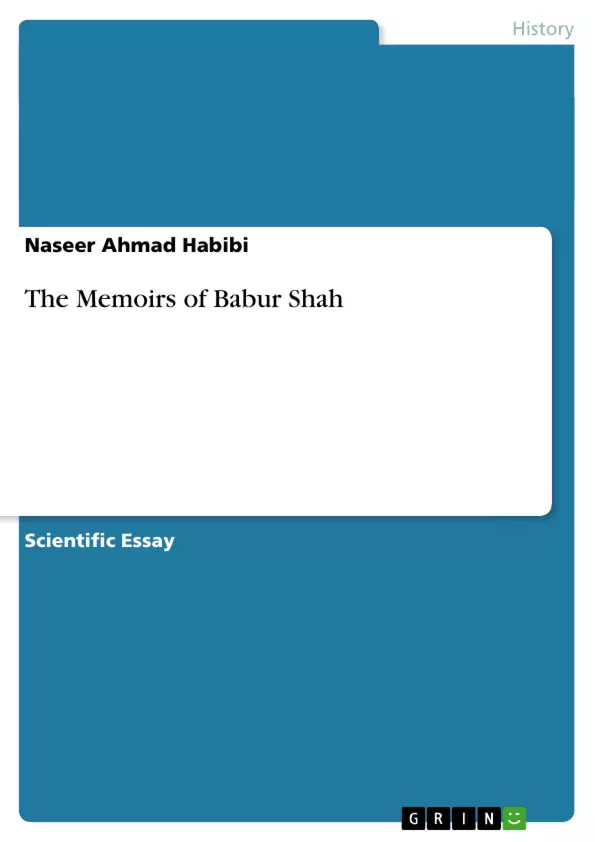The "Memoirs of Babur" or Baburnama are the work of the great-great-great-grandson of Timur (Tamerlane), Zahiruddin Muhammad Babur (1483-1530). As their most recent translator declares, "said to 'rank with the Confessions of St. Augustine and Rousseau, and the memoirs of Gibbon and Newton,' Babur's memoirs are the first--and until relatively recent times, the only--true autobiography in Islamic literature." The Baburnama tells the tale of the prince's struggle first to assert and defend his claim to the throne of Samarkand and the region of the Fergana Valley. After being driven out of Samarkand in 1501 by the Uzbek Shaibanids, he ultimately sought greener pastures, first in Kabul and then in northern India, where his descendants were the Moghul (Mughal) dynasty ruling in Delhi until 1858.
Inhaltsverzeichnis (Table of Contents)
- Description of Fergana
- Description of Samarkand
- Babur leaves Kesh and crosses the Mura Pass
- Babur takes Samarkand by surprise, July 28, 1500
- Babur in Samarkand
- Ali-Sher Nawa'i, the famous poet
- Babur leaves Samarkand, July 1501
- Babur in Dikhkat
- Shabaq (Shaibani) Khan's campaigns; winter conditions and mountain springs
- The acclaiming of the military standards according to Mongol tradition
- Babur's poverty in Tashkent
Zielsetzung und Themenschwerpunkte (Objectives and Key Themes)
The primary objective of this work is to provide a firsthand account of the life and experiences of Zahiruddin Muhammad Babur, the founder of the Mughal Empire in India. The text offers a unique glimpse into the political and social landscape of Central Asia during the 15th and 16th centuries, as seen through the eyes of a prominent figure. Key themes explored in the text include:- Political and military struggles for power in Central Asia
- Geographical descriptions of Central Asian regions, particularly Fergana and Samarkand
- The rich culture and society of the Timurid period, encompassing architecture, music, and literature
- The interactions and conflicts between different ethnic groups, including Turks, Uzbeks, and Mongols
- Babur's personal journey and his eventual conquest of northern India
Zusammenfassung der Kapitel (Chapter Summaries)
The text opens with a detailed description of the Fergana Valley, Babur's birthplace and early dominion. It delves into the region's geography, agriculture, and urban centers, highlighting the importance of Andijan, Osh, and Marghilan. The chapter also describes the diverse population of the Fergana Valley, encompassing Turks, Sarts, and Persian-speaking people. Notably, the chapter introduces the renowned poet Ali-Sher Nawa'i and his connection to the region.
Following the description of Fergana, the text moves on to a detailed account of Samarkand, a city of immense historical and cultural significance. Babur's narrative captures the city's splendor, highlighting its architecture, gardens, and bustling markets. He also recounts his attempts to conquer the city, ultimately leading to his defeat and subsequent exile.
The subsequent chapters narrate Babur's journey through Central Asia, including his escape from Samarkand, his struggles against the Uzbek leader Shaibani Khan, and his eventual arrival in Kabul. Throughout these chapters, Babur provides vivid accounts of his military campaigns, his encounters with various factions, and the harsh realities of war and exile.
The final section of the preview focuses on Babur's poverty and hardships in Tashkent. It highlights his dwindling resources, his dependence on allies, and the challenges he faced in rebuilding his power.
Schlüsselwörter (Keywords)
The main keywords and focus topics of the text include: Central Asia, Fergana, Samarkand, Timurid, Babur, Mughal Empire, political struggles, military campaigns, geography, culture, society, Uzbeks, Turks, Persian, literature, exile, conquest. These terms encapsulate the primary themes and concepts explored in the text, offering a comprehensive overview of the work.- Arbeit zitieren
- Naseer Ahmad Habibi (Autor:in), 2012, The Memoirs of Babur Shah, München, GRIN Verlag, https://www.grin.com/document/207717



